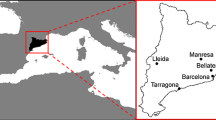Abstract
Hourly and daily counts of air-borne ragweed pollen, AMBROSIA SPP, taken with a volumetric sampler during the 1961 season at Ottawa, Canada, were compared with meteorological events. The time of daily peak concentration of pollen coincided with the time of decreasing relative humidity and development of a super-adiabatic lapse rate in the first 200 ft of atmosphere. Daily variations in pollen count were virtually completely dominated by the local ragweed population and microclimate but could be explained to a limited extent by variations in air mass.On occasions, gravity slide counts using a Durham type apparatus varied qualitatively with volumetric counts, but it was not possible to obtain a constant factor to convert gravity to volumetric counts.
Zusammenfassung
Die stündliche und tÄgliche Anzahl von Pollen des Jakobskreuzkrauts(AMBROSIA SPP.) in der Luft (mit einem volumeterischen Sammler bestimmt) wÄhrend der Saison 1961 in Ottawa, Kanada, wurde mit meteorologischen Daten korreliert. Die höchste Pollenzahl in der Luft fiel mit dem Abfall der rel. Feuchte zusammen und der Entwicklung eines überadiabatischen Gradienten in den ersten 65 m Höhe der AtmosphÄre. Die tÄglichen Schwankungen der Pollenzahl wurden tatsÄchlich vollstÄndig von der lokalen Verteilung der Ambrosia spp. und dem Mikroklima bestimmt und konnten nur in geringem Masse mit den Schwankungen der Luftmassen in Zusammenhang gebracht werden.Die Zahl der Pollen in durch Schwerkraft gewonnen Proben fiel gelegentlich qualitativ mit den volumetrisch gewonnen Proben zusammen; es war jedoch nicht möglich, einen konstanten Faktor zu berechnen, um gravimetrisch gewonnene Werte in volumetrische umzuwandeln.
Résumé
Le nombre par heure et par jour, des grains de pollen de AMBROSIA SPP. dans l'air, mesuré par un collecteur volumétrique pendant la saison 1961 à Ottawa (Canada)a été comparé avec les données météorologiques.Le nombre le plus élevé correspondait à une chute de l'humidité relative et à un gradient superadiabatique s'élevant jusqu'à 65m d'altitude. La cause des variations quotidienne du nombre des grains de pollen correspondait pratiquement à la distribution locale de Ambrosia spp. et au microclimat, et ne correspondait que dans une faible mesure avec les déplacement des masses d'air. Le nombre des grains de pollen obtenus par gravitation au moyen d'un appareil du type Durham coincidait parfois qualitativement aux valeurs obtenues par un collecteur volumétrique, mars il n'a pas été possible d'établir un facteur constant,qui permÎt de transformer les valeurs gravimétriques en valeurs volumétriques.
Similar content being viewed by others
References
BIANCHI, D.E., SCHWEMMIN and WAGNER W.H. Jr. (1959): Pollen release in common ragweed (AMBROSIA ARTEMISIIFOLIA). Bot. Gz., 120: 235–243.
DINGLE, A.N. (1955): A meteorological approach to the hay fever problem.J. Allergy, 26: 297–304.
DINGLE, A.N. (1957a): Meteorological considerations in ragweed hay fever research. Fed. Proc, 16: 615–627.
DINGLE, A.N. (1957b): Hay fever pollen counts and some weather effects.Bull.Am. Met.Soc., 38: 465–469.
DINGLE, A.N., GILL G.C., WAGNER Jr., W.H., and HEWSON E.W. (1959): The emission dispersion, and deposition of ragweed pollen. Symposinm Atmos. Diff. and Air Poll. Advances in Geophysics, Vol.6, ed. F.N. Frenkiel and P.A. Sheppard, Academic Press, London, pp.471.
GILBERT, G.E. (1960): Volumetric and gravity slide tests for air-borne ragweed and oak pollens at Columbus, Ohio. Ohio J. Sci.,50:60–70.
GOODWIN, J.E., McLEAN, J.A., HEMPHILL F.M. and SHELDON J.M. (1957): Air pollution by ragweed: Medical aspects. Fed.Proc, 16: 628–631.
HARRINGTON, J.B., GILL, G.C. and WARR, B.P. (1959): High efficiency pollen samplers for use in clinical allergy. J. Allergy, 30: 357–375.
HEWSON E.W. (1960): Industrial air pollution meteorology.Ann Arbor, Michigan, Univ. of Michigan, Meteorological Laboratories. Univ. of Michigan Press, pp. 191.
JONES, M.D. (1952): Time of day of pollen shedding of some hay fever plants. J. Allergy, 23: 247–258.
OGDEN, E.C., and RAYNOR, G.S. (1960): Field evaluation of ragweed pollen samplers. J. Allergy, 31: 307–316.
SMITH, R.D. and BROOKS, P. (1954): The diurnal variation of air-borne ragweed pollen as determined by a continuous recording particle sampler and implications of the study. J. Allergy, 25: 36–45.
VOISEY, P.W. and BASSETT, I.J. (1961): A new continuous pollen sampler. Can. J. Pl. Sci., 41: 849–853.
Author information
Authors and Affiliations
Rights and permissions
About this article
Cite this article
Holmes, R.M., Bassett, I.J. Effect of meteorological events on ragweed pollen count. Int J Biometeorol 7, 27–34 (1963). https://doi.org/10.1007/BF02189179
Received:
Issue Date:
DOI: https://doi.org/10.1007/BF02189179




